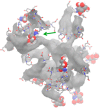Molecular Modeling to Study Dendrimers for Biomedical Applications
- PMID: 25493631
- PMCID: PMC6270869
- DOI: 10.3390/molecules191220424
Molecular Modeling to Study Dendrimers for Biomedical Applications
Abstract
Molecular modeling techniques provide a powerful tool to study the properties of molecules and their interactions at the molecular level. The use of computational techniques to predict interaction patterns and molecular properties can inform the design of drug delivery systems and therapeutic agents. Dendrimers are hyperbranched macromolecular structures that comprise repetitive building blocks and have defined architecture and functionality. Their unique structural features can be exploited to design novel carriers for both therapeutic and diagnostic agents. Many studies have been performed to iteratively optimise the properties of dendrimers in solution as well as their interaction with drugs, nucleic acids, proteins and lipid membranes. Key features including dendrimer size and surface have been revealed that can be modified to increase their performance as drug carriers. Computational studies have supported experimental work by providing valuable insights about dendrimer structure and possible molecular interactions at the molecular level. The progress in computational simulation techniques and models provides a basis to improve our ability to better predict and understand the biological activities and interactions of dendrimers. This review will focus on the use of molecular modeling tools for the study and design of dendrimers, with particular emphasis on the efforts that have been made to improve the efficacy of this class of molecules in biomedical applications.
Conflict of interest statement
The authors declare no conflict of interests.
Figures










References
-
- Tomalia D.A. Birth of a new macromolecular architecture: Dendrimers as quantized building blocks for nanoscale synthetic polymer chemistry. Prog. Polym. Sci. 2005;30:294–324.
-
- Hodge P. Polymer science branches out. Nature. 1993;362:18–19. doi: 10.1038/362018a0. - DOI
-
- Klajnert B., Bryszewska M. Dendrimers: Properties and applications. Acta Biochim. Pol. 2001;48:199–208. - PubMed
Publication types
LinkOut - more resources
Full Text Sources
Other Literature Sources

